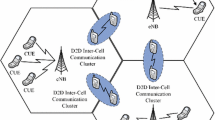Conclusion
MIMO communication is an indispensable key technology for the 6G wireless network. Under the requirement of extremely low-latency communication in 6G, the MIMO capacity exhibits the channel capacity collapse effect. The spatiotemporal exchangeability theory of MIMO channel and the spatiotemporal 2-D channel coding are promising approaches to combat this effect and to enable extreme connectivity for 6G. Fundamental researches in this area are still in its beginnings. Comprehensive simulation validations and constructing experimental systems in practical scenarios are necessary to further validate relevant theories and technologies. They are helpful to promote research in this area towards maturity.
Similar content being viewed by others
References
You X H, Wang C X, Huang J, et al. Towards 6G wireless communication networks: vision, enabling technologies, and new paradigm shifts. Sci China Inf Sci, 2021, 64: 110301
IMT-2030 (6G) Promotion Group. White Paper on 6G Overall Vision and Potential Key Technologies. White Paper, 2021, http://www.caict.ac.cn/kxyj/qwfb/ztbg/202106/P020210604552573543918.pdf
Polyanskiy Y, Poor H V, Verdu S. Channel coding rate in the finite blocklength regime. IEEE Trans Inform Theor, 2010, 56: 2307–2359
You X H, Sheng B, Huang Y, et al. Closed-form approximation for performance bound of finite blocklength massive MIMO transmission. 2022. ArXiv:2206.07243
You X H, Zhang C, Sheng B, et al. Spatiotemporal 2-D channel coding for very low latency reliable MIMO transmission. In: Proceedings of IEEE Global Communications Conference (GLOBECOM), 2022
Brady J, Behdad N, Sayeed A M. Beamspace MIMO for millimeter-wave communications: system architecture, modeling, analysis, and measurements. IEEE Trans Antennas Propagat, 2013, 61: 3814–3827
Yang X, Li X, Zhang S L, et al. On the ergodic capacity of mmWave systems under finite-dimensional channels. IEEE Trans Wireless Commun, 2019, 18: 5440–5453
Acknowledgements
This work was supported by National Key Research and Development Program of China (Grant No. 2020YFB1806600). The author would like to thank Dr. Wei XU, Dr. Bin SHENG, Dr. Chuan ZHANG, Dr. Yongming HUANG, and some others from the National Mobile Communications Research Laboratory, Southeast University, for useful discussions on preparing this perspective.
Author information
Authors and Affiliations
Corresponding author
Rights and permissions
About this article
Cite this article
You, X. 6G extreme connectivity via exploring spatiotemporal exchangeability. Sci. China Inf. Sci. 66, 130306 (2023). https://doi.org/10.1007/s11432-022-3598-4
Received:
Accepted:
Published:
DOI: https://doi.org/10.1007/s11432-022-3598-4




